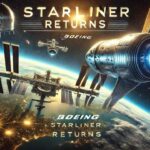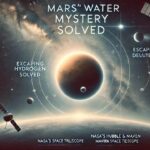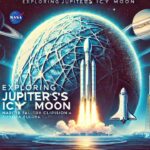NASA, SpaceX, Boeing Starliner, Crew Dragon, ISS, space mission, space exploration, aerospace industry, astronaut rescue, commercial spaceflight, propulsion issues, human spaceflight, space program
Discover the challenges faced by NASA’s astronauts aboard Boeing’s Starliner spacecraft and the potential rescue mission involving SpaceX’s Crew Dragon. This article explores the technical issues, NASA’s decision-making process, and the broader implications for the aerospace industry.

NASA Considers SpaceX Rescue for Stranded Boeing Starliner Crew: A Major Setback for Boeing
In a significant development for the aerospace industry, NASA is weighing the possibility of bringing home astronauts stranded on the International Space Station (ISS) aboard a SpaceX Crew Dragon capsule. This potential rescue mission is a considerable embarrassment for Boeing, whose Starliner spacecraft encountered serious propulsion issues during its recent flight to the ISS.
Prolonged Mission for Boeing’s First Crewed Flight
Originally intended as a week-long mission, the journey for NASA astronauts Butch Wilmore and Suni Williams aboard Boeing’s Starliner could extend to an unprecedented eight months. The propulsion issues, which emerged during the spacecraft’s ascent to the ISS in June, have cast doubt on its reliability and safety, prompting NASA to consider alternative solutions.
A final decision on whether to continue with the Starliner or opt for SpaceX’s Crew Dragon for the return journey is expected later this month. Detailed planning is already in motion, with SpaceX potentially launching its Crew-9 mission on September 24 with only two astronauts, instead of the usual four, to accommodate the return of the Starliner crew in February 2025.
Intense Deliberations and Technical Troubles
NASA’s Commercial Crew Programme Manager, Steve Stich, disclosed that there have been rigorous discussions about the best course of action. Boeing remains confident in its spacecraft, having conducted extensive ground testing to replicate the technical issues encountered in space. However, NASA officials are keen to understand the root causes and underlying physics of the problems.
Notably, Boeing representatives were absent from the recent briefing, underscoring a possible rift between NASA and Boeing. On August 2, Boeing released a blog update expressing confidence in the Starliner’s capability to return the crew safely.
The spacecraft’s thrusters experienced a loss of power as it approached the ISS, and several helium leaks—used to pressurize the propulsion system—were detected. Tests at the White Sands Testing Facility in New Mexico aim to uncover the reasons behind these malfunctions. The latest analysis suggests that a “poppet” valve may have choked the fuel flow, and overheating might have caused some fuel to vaporize. Additionally, undersized seals might be responsible for the helium leaks.
Potential Setback for Boeing
Despite the challenges, NASA’s Ken Bowersox, Associate Administrator for NASA’s Space Operations Mission Directorate, emphasized that returning with the Starliner remains the “prime option.” However, if the astronauts return with SpaceX, it would mark the most significant setback for Boeing’s space program to date. This comes at a time when Boeing is still recovering from the safety crisis affecting its commercial planes.
Both Boeing and SpaceX were awarded multibillion-dollar contracts in 2014 to provide NASA with transportation to the ISS after the space shuttle program ended in 2011. The shuttle program’s conclusion left the United States reliant on Russian Soyuz rockets for crew transportation. SpaceX succeeded with its first crewed test in 2020 and has since carried dozens of people. In contrast, Boeing’s program has faced numerous delays and setbacks, including a software bug that misaligned the spacecraft’s trajectory during its first uncrewed test and the discovery of flammable electrical tape in the cabin after the second uncrewed test.
The crewed test also experienced two aborted launch attempts, both occurring while the astronauts were strapped in and ready for lift-off.
The Road Ahead
NASA’s decision on whether to proceed with Boeing’s Starliner or switch to SpaceX’s Crew Dragon will be closely watched by the aerospace community. This situation underscores the challenges and risks involved in human spaceflight and the importance of robust testing and validation processes.
If the decision favors SpaceX, it could bolster SpaceX’s reputation as a reliable partner for NASA and further establish its dominance in the commercial spaceflight sector. Conversely, it would be a considerable blow to Boeing, highlighting the difficulties the company has faced in developing a competitive spacecraft for human spaceflight.
Implications for the Commercial Space Industry
The potential use of SpaceX’s Crew Dragon to rescue Boeing’s stranded crew highlights the competitive and collaborative dynamics within the commercial space industry. Both companies are crucial to NASA’s strategy of leveraging private sector innovation to maintain and expand its human spaceflight capabilities.
SpaceX’s success with Crew Dragon demonstrates the viability of NASA’s commercial crew program, which aims to foster a market-driven approach to space transportation. However, Boeing’s struggles with the Starliner reflect the inherent complexities and technical challenges associated with developing new spacecraft.
If Boeing can resolve the issues with the Starliner, it would still have an opportunity to become a significant player in the commercial space sector. The company’s extensive experience in aerospace and its historical contributions to space exploration give it a strong foundation to build upon. However, overcoming the current setbacks will require substantial technical and managerial efforts.
Conclusion
The situation involving NASA, Boeing, and SpaceX is a poignant reminder of the challenges of space exploration and the importance of rigorous testing and validation. As NASA prepares to make a final decision on the matter, the aerospace industry watches closely, recognizing the implications for the future of commercial spaceflight.
For Boeing, resolving the issues with the Starliner is critical to restoring confidence in its space program and maintaining its position as a key player in human spaceflight. For SpaceX, the potential rescue mission underscores its growing role in supporting NASA’s missions and highlights the success of its Crew Dragon spacecraft.
Ultimately, NASA’s choice will reflect its commitment to astronaut safety and mission success, guiding the future direction of human space exploration.
Read More
- NASA and Sierra Space Dream Chaser Arrives in Florida for Launch Prep
- NASA Awards Cutting-Edge Technologies for Future Habitable Worlds Mission
- NASA Invites Media to Northrop Grumman 21st Station Resupply Launch
- NASAs Perseverance Rover Discovers Potential Signs of Ancient Life in Mars Rock










